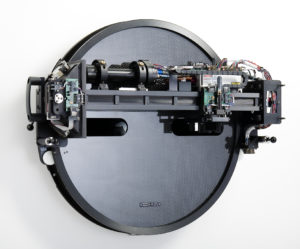ITT Corporation was responsible for five NASA Space Shuttle tracking telescope systems at the launch site in Cape Canaveral Florida. These telescopes, called ATOTS, MIGOR, and DOAMS, were used for various types of downrange imaging of shuttle launches. The telescopes were exhibiting less than optimal imaging characteristics from out of focus camera images. ITT was looking for a method to realign and precisely focus the high-speed cameras on each of these tracking telescopes. The solution needed to be simple, robust and cost effective. It also needed to operate on-site at each telescope installation.
Optikos engineers developed a solution inspired by a common optical design approach: ray tracing. By tracing single rays of light into the telescope system and monitoring the characteristics of that ray on the image plane, system focus can be determined and optimized.
If the camera’s image plane is forward of the best focus position, then the ray traces across the image plane in one direction. If the image plane is behind best focus, then the ray traces in the opposite direction. At best focus, the spot is fixed. The alignment system watches the behavior of the single ray as it moves across the image plane and gives the precise location of best focus.
The Optikos alignment system uses a lateral stage system, a laser, opto-mechanical stages, and a sophisticated optics assembly to insure that the “ray” of light remains parallel as it traverses across the telescope aperture. The optics is intolerant to small mechanical stage errors, so near perfect parallelism is maintained across the full aperture. In addition, the system incorporates precision tip and tilt controls to steer the light ray into off-axis conditions. Scanning off-axis rays allows the user to determine the magnitude and direction of image plane tilt, which can be corrected in the adjustable camera mount.
Because this alignment system was required to operate in the field, our engineers needed to build a system that could handle the environmental extremes of Florida. The opto-mechanics were all athermalized to ensure good performance over a wide range of temperatures. The unit was also sealed, providing years of error-free testing.
Optikos successfully installed five alignment systems in the field. Our customer reported great success in improving the quality of images from each of the telescope systems.
Have a project in mind? Get started here.



